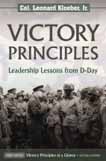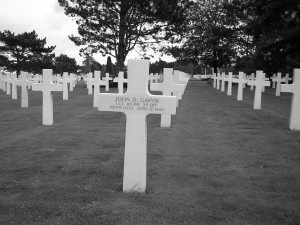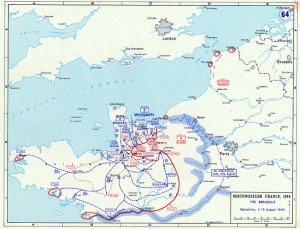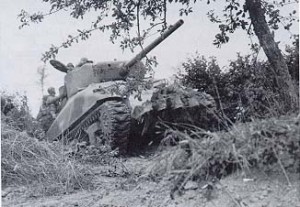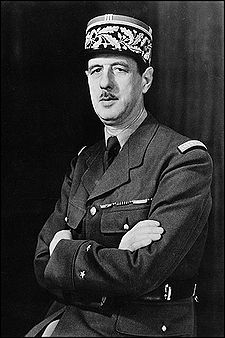Archive for the ‘D-Day’ tag
Veterans Day
These week we celebrated Veterans Day in the United States to honor those who have served the country and those who are still serving. As we remember our living veterans let us not forget those who are no longer with us. As a poet once said: “All gave some, but some gave all.” You can find information about the various military cemeteries in Normandy, France by linking to them from the links provided on this site. If you link to the American Cemetery, here is some of what you will find:
The Normandy American Cemetery and Memorial in France is located on the site of the temporary American St. Laurent Cemetery, established by the U.S. First Army on June 8, 1944 and the first American cemetery on European soil in World War II. The cemetery site, at the north end of its ½ mile access road, covers 172.5 acres and contains the graves of 9,387 of our military dead, most of whom lost their lives in the D-Day landings and ensuing operations. On the Walls of the Missing in a semicircular garden on the east side of the memorial are inscribed 1,557 names. Rosettes mark the names of those since recovered and identified.
The memorial consists of a semicircular colonnade with a loggia at each end containing large maps and narratives of the military operations; at the center is the bronze statue, “Spirit of American Youth.” An orientation table overlooking the beach depicts the landings in Normandy. Facing west at the memorial, one sees in the foreground the reflecting pool; beyond is the burial area with a circular chapel and, at the far end, granite statues representing the U.S. and France.
Pegasus Bridge –Part Two – Mission Success
At seven minutes after midnight on June 6th 1944, the gliders cut loose from their Halifax bomber tow-planes and began their silent descent into Normandy. The first three gliders made controlled crash landings at sixtteen minutes after midnight in the narrow strip of land between the two bridges and came to rest within meters of the bridge over the Caen Canal. They had achieved complete surprise, but with the hard landings, the occupants of the gliders were temporarily stunned. They quickly recovered, and as they had practiced on numerous occasions, they regrouped and jumped into action to overwhelm the few sentries on the bridge. Major Howard established his command post and pushed his men forward into the nearby villages of Benouville and Le Port to set up road blocks on key junctions to defend against an expected counter-attack. Within less than 20 minutes they had achieved one of their primary objectives in seizing the Canal Bridge, but at a high cost: all three platoon leaders and several of the non-commissioned officers were casualties. Now it was up to junior leaders to complete the rest of the mission – “hold until relieved.”
On the other side of the narrow strip between the canal and the Orne River, two of the gliders landed near their bridge, but the other mistakenly landed over two kilometers away. Despite the loss of one third of their strength, the remaining two platoons succeeded in seizing the river bridge. With the bridges secure, the engineers were disarming the explosives that were set by the Germans, Dr. Vaughn was setting up his aide station, an d Major Howard’s radio operator was sending the success signal: “Ham and Jam” onto higher headquarters. Then, just before 0100 hours, the paratroops of the British 6th Airborne began to drop from the sky. One of their battalions had the mission to join Major Howard’s D Company at the bridges. Like all the paratroopers that night, they were scattered and mis-dropped away from their intended drop zones. Nevertheless, the battalion commander, decided to proceed to the bridges even though he had only gathered about one third of his force. Isolated groups of paratroopers would infiltrate into the British lines throughout the night.
Meanwhile the Germans were preparing to counter-attack as they were trained to do. Their experienced commanders knew that it was best to launch an immediate attack before the British could set up a defense. One of the regimental commanders from the 21st Panzer Division, Colonel Von Luck, put his men on alert in the vicinity of Caen, but could not proceed without orders. The German high command had maintained tight control on all their armored formations and most even required approval from Hitler himself before they could be employed. Approval would be slow to come; however, small advance panzer elements were near the vicinity of the canal bridge, and they started a probing attack. Although they were not exactly sure of the situation a few tanks and infantry in self-propelled vehicles slowly clanked toward the bridges. As they proceeded, one of the British sergeants positioned himself with a PAIT gun, a crude anti-tank weapon. Sergeant Thorton courageously waited until he had a good shot and was able to knock the lead tank out of action. Fearing that the British had additional anti-tank capabilities, the Germans decided to hold off until they could get a better picture of the situation in daylight; nevertheless, they kept up infantry probes and their snipers engaged targets in and around the bridge. Realizing the importance of the bridges, the Germans mounted other attacks throughout the night including using a river gunboat and frogmen. Again using only the light weapons they had brought with them and some of the German weapons that they had captured, the British held off these advances throughout the night and into the morning.
At around 0730, the British 3rd Infantry Division accompanied by Commandos began landing on Sword Beach. As they proceed inland, they met more determined resistance at prepared strong-points. The 21st Panzer had finally been ordered into the battle and was proceeding in the direction of the beach. Further counterattacks on the bridgehead took their toll, but the glider men and the paratroops held on. Then at about 1300 hours, they heard the sound of bagpipes. It was bagpiper, Bill Millin, leading the way for Lord Lovat’s British Commandos who were bringing with them British armor and heavy weapons. With their arrival, Major Howard could now say that he had fully accomplished his mission; however the price in causalities was heavy. History now remembers this action as the Battle of Pegasus Bridge and the bridge was so named in honor of the Pegasus insignia of the British Airborne.
Here is a link to a Google map of the bridge today: Google Map Pegasus
History Fans, check out these links
For the history fans who visit this site, you can find some very interesting links in our history section in the column to the right. The links will take you to other sites including the US and UK National Archives, The US Army Center for Military History, and some interesting videos: ” Silent Wings” which is about the glider assaults in Normandy, The History Channel and the American Experience which link to their version of the D-Day events, and “Rare Color Film” which speaks for itself since most of the actual footage shot in WWII was in black and white. Additionally you can see some interesting still photographs at the Life Magazine site.
So if you like history and are interested in learning more about what happened on June 6, 1944 these are some great references that you can simply “click-on” to without having to do the research. If you have any friends who might also have an interest, sent them here by using the share button on this post. Learn from History!
The Normandy Campaign Draws to an End
Sixty-five years ago this month, the Normandy Campaign was coming to an end after almost ninety days of brutal combat between the Allied armies and the German Wehrmacht. It began on June 6th, D-Day when British and American paratroopers jumped into the Cotiten Peninsula to secure key terrain and disrupt the Germans in advance of the assault divisions that landed on five beaches stretching for fifty miles along the coast of Northern France. Their mission was to secure a lodgement, destroy the German forces, and liberate Europe from Nazi tyranny. Although there was bitter fighting right from the start of the invasion, it only grew more intense over the next few months as they fought in the Bocage of the peninsula which was a patchwork of hedgerows. The hedgerows provided a natural defensive position from which the Germans could effectively blunt any Allied advance, and they successfully used machine guns and artillery to great advantage. Despite the Allied advantage in air power and naval gunfire , the Germans put up a stiff resistance. Their army was well trained, had combat experience, and many units, specifically the SS, were fanatical fighters who were dedicated to the Nazi regime.
Over the next few months, Allied commanders launched a series of attacks and utilized their superior air and naval forces to prepare the advance. Tragically, there were many occasions where incidents of friendly fire took place as bombs fell short of their intended targets, and Allied soldiers were killed or wounded even before the operations commenced. Yet they remained fixed on their mission, and demonstrated resilience to continue to pursue the Germans relentlessly. Resilience was crucial to the success for the Allies. It is the simple quality of an organization or individuals to overcome setbacks, and spring back so they can move ahead towards their intended objectives. Time after time, Allied soldiers and their commanders were able to overcome significant losses and rebound in spite of them.
As the weeks past, the Allies continued to bring more men and equipment into the fight while the Germans could not replace their losses. Among the German losses were some senior commanders, include Field Marshal Rommel. He was seriously injured when his staff car was attacked by an Allied fighter plane while he was traveling to visit the units at the front lines of the battle. Visiting the front at the crucial points was his custom and one of the reasons why he was one of the most effective German commanders. As the German losses mounted, their ability to counter attack was diminished. Nevertheless, Hitler demanded more aggressive action from the safety of his headquarters in East Prussia. In frustration, Hitler replaced his Commander-in-Chief, Field Marshal von Rundstedt, with Field Marshall von Kluge. When he arrived in Normandy, Kluge originally thought that the biggest problem for the Germans was a lack of leadership, but as he visited the front lines, he too quickly realized that the German army simply was not able to withstand the onslaught without more replacements and support. On July 20th, an attempt was made on Hitler’s life when a bomb was set off in his bunker in East Prussia, but he sustained only minor injuries. Although his injuries were only minor, he was ruthless in pursuing the perpetrators which included a number of regular army officers. Kluge was concerned about being implicated in the plot, so when Hitler ordered a major counter attack against the Americans from the German left flank, Kluge reluctantly carried out the order even though he knew it was the wrong strategy from purely a military standpoint. This attack at Mortain only played into the Allied plan as it was held in check while the newly activated American Third Army under General Patton broke out of the hedgerow country with his armored and mechanized formations to envelop the flank of the German Army. Within a matter of days, the German attack was completely contained, and the Americans were able to advance almost unopposed into the German rear areas.
Patton drove his troops relentlessly to continue their attack so that the Germans would not have time to recover. This was exactly the right strategy. He exploited success and when necessary even by-passed pockets of resistance to keep up the momentum. By mid-August many of the German units were depleted and beginning to break down under the stress of constant combat. After encircling most of the German Army, the Americans and British attempted to complete the encirclement at Falaise. The Canadians and Poles were attacking from the north towards Falaise while Patton’s Americans and the French 2nd Armored Division were attacking north intending to meet up with them. After reaching Argentan, Patton was ordered to stop his advance to avoid a friendly fire incident with the Canadians and Poles; however, the Canadians and Poles had run into determined resistance from SS Panzer units that were trying to keep the Gap open so that others could escape east across the Seine River to fight another day. In this, they were successful for awhile, but eventually the gap was closed and the Allied air forces relentlessly attacked any Germans on the road moving east. By the end of August, the remaining Germans who were not killed inside the “Falise Pocket” surrendered to the Allies. Knowing that he would be blamed for the defeat, Kluge took his life with a cyinad pill. Meanwhile, the German commander in Paris defied Hitler’s orders to destroy the city and defend it to the last man. He declared it an “open city” and so it was fortunately spared the fate of many of the smaller villages and cites in Normandy that were ruined during the preceding weeks of brutal combat. The Free French Forces under the command of General LeClerc were given the honor to be the first Allied troops to enter Paris.
With the liberation of Paris, the Normandy campaign was officially over, but price in terms of casualties and destruction of property had been great. Not just for the armies, but also for the many French civilians who were killed, wounded, or displaced from their homes that were destroyed. Almost 20,000 were killed and many more wounded. Cities like Caen and St. Lo were reduced to a pile of rubble. Many other towns were partially runied as the Germans and the Allies traded artillery barges, or when Allied bombers dropped their payloads in advance of the attack. In the process of liberating the Continent, much of it was destroyed. It is significant the the Free French Forces joined the Allied effort with the full knowledge that their country would suffer so much in the process. Following the Normandy Campaign, there would still be months of bitter fighting all through the winter of 1944-45. The Allied Supreme Commander, General Eisenhower, would be challenged not only by the Germans, but also by the infighting among the Allied commanders. However, he successfully led the coalition to complete his mission that he started on June 6th when the Germans finally surrendered unconditionally in May 1945. So, as Prime Minister Churchill aptly stated, although Normandy was not the end, perhaps it was the beginning of the end.
VICTORY Principles at-a-glance
VICTORY Principles at-a-glance is a one page overview of the leadership lessons illustrated by the historic events of D-Day that I have written about in my recently published book. As the author, I wanted to provide readers with an easy-to-use reference that would summarize the core principles succinctly so they could keep it as a handy reference. Although my book is based on a World War II narrative, theme of the book is about leadership. My own experience tells me that leadership is an art and not a science. This means that there is no recipe that one can follow that will guarantee that one would become a successful, much less a great leader. However, like all other artists, leaders must work at their craft to perfect their own special style and approach given their own circumstances. Many of the now famous senior leaders during World War II had perfected their leadership skills over the two prior decades between the World Wars. Many of them often toiled in anonymity in jobs that were not very exciting, but which offered them the opportunity to practice their craft as leaders. It was because of their experience that they were ready to assume the positions of much greater responsibility when the time came. So if you aspire to be a successful leader, take advantage of any opportunity you have in front of you to start learning your craft.
Despite the wide range of styles and approaches of successful leaders, I truely believe that there are certain bedrock leadership principles that all leaders incorporate into their approach. Leaders who don’t follow these principles will likely never succeed to their full capability, even if they achieve some level of success. After spending a significant part of my own career in leadership positions and observing other leaders around me, I have identified these seven principles that I believe all leaders rely upon. You can find these VICTORY Principles at-a-glance in a PDF document that you can download by searching the tool bar to the right under bonus documents or you can click on this link:
VICTORY Principles at-a-glance
Learn from History: Innovation Leads to Success
War is one of the most tragic of all human endeavors when measured in loss of life and property, suffering of all the participants, and the cost of rebuilding after the final shot has been fired. In spite of the horrific consequences of war, it illustrates that even under the harshest of circumstances, innovation and learning are critical to survival and also essential ingredients to success. Students of history will understand that successful military operations have been the result of “learning on the fly.” Successful armies learn how to defeat the enemy by adapting to their tactics, by innovating new tactical solutions of their own, and by finding new ways to use the resources available. These same concepts of learning apply to success in business by adapting your competitor’s tactics and leveraging your own resources in the marketplace. While the analogy of war and business is not perfect, it does offer some valuable insights. Let’s look at the Normandy campaign in World War II as an example.
After the Allied armies had established a beachhead on the Normandy coast of France following the D-Day invasion on June 6th 1944, the fighting became protracted and intense in the Norman hedgerows. Many of the objectives that were expected to be achieved in the first few days were not actually realized until a month or more into the campaign as the fighting bogged down in the “Bocage” country. This was where farmers had raised their cattle and grown crops since before Norman the Conqueror had left the same area to sail across the English Channel almost 1000 years before. Over the centuries they had built natural fences from mounds of dirt where they planted shrubs and trees to form barriers of dense vegetation to separate their fields. These are known as hedgerows. Usually the hedgerows surrounded a field and only had a small opening from which you could enter the enclosed area. Hedgerows provided the Germans with natural defensive positions from which to defend against the advancing Allied armies. By strategically emplacing machine guns that targeted the entrances to these fields and also using pre-arranged artillery and mortar fire, they could easily slow down an Allied advance and inflict many casualties. Even tanks were vulnerable to attack when they penetrated the hedgerows through the natural openings and were hit by anti-tank weapons and artillery.
Then one day, Sergeant Curtis G. Culin of the American 102nd Cavalry, 2nd Armored Division decided that if he could weld some steel prongs on his tank, then he could literally plow through a hedgerow at an unexpected place quickly and avoid the pre-sited German fire. It worked! General Omar Bradley, then in command of the American army, ordered this adaptation be made to tanks in other units too. Ironically they were able to use the same steel girders that the Germans had used for beach obstacles as a source for the metal needed to modify the tanks. Thereafter, the Allied armies were able to more easily attack into the hedgerows with fewer casualties. This innovation and learning under fire saved American lives and contributed to the eventual defeat of the German army in Normandy. It is but one good example of how “learning on the fly” can lead to success, even where the concept is quiet simple and maybe even obvious once it is implemented.
This same concept of learning and innovation can also be applied to business. One of the industries that has thrived on innovation and learning to improve products and services is the fast food industry. Competitors in this industry constantly look for ways to do things easier, faster, and more reliably. You can find examples at McDonalds where they have used innovations over the years to cook their French Fries and hamburgers uniformly or make milk shakes quickly, or at Taco Bell where they have perfected the art of making a taco or enchilada. They have done this by designing kitchen equipment that is almost foolproof and produces similar results each time, even where their workers may have limited experience. Often these innovations come from their franchisees who have learned lessons the hard way and not from the corporate headquarters. So it is important for leaders to be alert and listening to those on the front lines, just as General Bradley listened to Sergeant Culin sixty five years ago.
Make learning and innovation a part of your organization. Experiment. Take small risks. Try new approaches. Small successes and innovations when taken together can have a huge impact on the bottom line and your overall results. If you are a leader, encourage this kind of behavior and make it a part of the organizational culture. Be careful not to stifle this activity by punishing failure. Often the experiments may not work, but when they do, the can have a big payoff. If you punish people who try and fail, word will get around quickly. Others will choose to play it safe and not look for ways to improve. So if you want to encourage innovation you need to positively encourage your people even when they fall short. Obviously, you should also celebrate success when someone tries and succeeds. Public recognition will also get the message across that you want to look for ways to improve. So start by looking for the small wins, and then build from there. Make innovation and learning a part of your success.
Charles de Gaulle – Leader of the Free French Forces
Charles de Gaulle was the self-anointed leader of the Free French Forces and landed on Juno Beach on June 13, 1944 to assert his authority as leader of the Provisional Government of France following the D-Day invasion.
General de Gaulle was born in 1890 into an aristocratic family that had roots in French Flanders. As a young man, he developed an interest in history and went to college in Paris before deciding on a military career and attending the French military academy, St. Cyr. He graduated from the four year course at St. Cyr and was commissioned as an infantry officer in 1912. During the first World War, he was wounded at the Battle of Verdun in 1916 and taken prisoner by the German Army. After the war, he served in Poland as an instructor to the Polish Army during thier conflict with the Russian army in the early 1920’s. Following his service in Poland, her returned to France and was a staff officer and an instructor at the Ecole Militaire. During this period he became student of armored warfare similar to some of his contemporaries in the German, British and American armies who also were developing theories about maneuver warfare. During these interwar years, he began publishing articles about his theroies and views, which were often criticized by other French officers and senior leaders.
At the beginning of WWII, he was a Colonel in command of a tank brigade, but when the German blitzkrieg attack began, he was quickly promoted to command the French 4th Armored Division and the rank of Brigadier General. Although he lacked air support, he immediately attacked the German army as it was invading France in 1940 and had some limited successes, but could not defeat the superior German force. Eventually, he became the French liason officer to the British, where he sought their help following the surrender of France by Marshal Petain. After fleeing to the safety of England, de Gaulle set about organizing the Free French Forces to oppose the German occupation and fight with the Allies. Despite the support he received from both the British and later the Americans, de Gaulle proved to be a difficult partner for the Allies. He was always suspicious of the Allies’s intentions and they were likewise unsure of de Gaulle. Consequently, they did not include him in their plans for Operation Overlord until the eve of the invasion. Shortly after D-Day, he landed on French soil and quickly moved to take command of all Free French Forces. When Paris was finally liberated, de Gaulle staged a grand entrance and made a famous speech to the French people where upon he was made President of the Provisional Government of the French Republic. He then went about fielding the French First Army which joined the Allies for the invasion of southern France and the eventually defeat the German army. De Gaulle resigned his position after the war, but was later elected President of France with the founding of the 5th Republic in 1958. He held this post until 1969. His tenure is remembered for his strong assertion of French independence and nationalism during the height of the Cold War era of the global struggle between the Western nations and the Soviets. De Gaulle died in 1970 at the age of 80.
As a leader, de Gaulle exemplified the Victory Principles. He certainly had a vision of a free, independent French nation which he championed ardently throughout the period of WWII and thereafter. His values of putting French national interests first often caused him to be a difficult partner to work with from the viewpoint of his allies, but he tenaciously pursued what he thought were the best interests for the French Republic. He demonstrated resilience by overcoming many difficulties in organizing Free French Forces during the war, and asserting his political will over both his political adversaries in France and within the Allied governments to become the leader of the Provisional Government of France. Finally, he always put the interests of his country and team first which was best illustrated by his refusal to accept a pension for his service as president and general, and instead chose to be paid a pension for a colonel, the rank from which he rose at the beginning of the war. Without a doubt he was a controversial leader, but no one can ever say that he put his personal interests ahead of those of his nation or the people. He was a strong leader for France when France needed him.
For more information follow this link: http://en.wikipedia.org/wiki/Charles_DeGaulle
Learn from History: Leadership requires a vision
Sixty-Five years ago, Allied armies under the command of General Dwight D. Eisenhower stormed the beaches at Normandy to liberate Europe and end World War II. This was and still remains one of the most complex military operations ever undertaken. It was planned and executed without the help of modern communications and computers that we now take for granted. So what can we learn from these historical events of over a half century ago that could help us today? Leadership.
The successful Allied invasion was the result of superior leadership starting with General Eisenhower, the Supreme Commander, and continued all the way down to the sergeants and junior officers that led the troops into battle. While the Germans also had some good individual leaders like Field Marshal Erwin Rommel, as a group, the did not share the same vision on how they would defend the beaches. Thus, what started as a foothold on the continent by the Allies grew into a major assault that could not be contained. The leadership provided by General Eisenhower and his subordinates became a major factor as the Allies fought together as a team. The Allies were able to eventually land enough troops and supplies while the Germans could not replace their losses. After some very difficult fighting, the American Third Army under the leadership of General Patton broke through the German lines. Once the breakout occurred the Germans were about to be surrounded. Those that could escape to fight another day retreated while the vast majority were either casualties or became prisoners of war.
The same principles of leadership used by the Allied commanders are universal leadership principles that can applied even today. Given the complex challenges facing the country, it will be excellent leadership that carries us forward to a better day, just as it did sixty-five years ago.
Today more than ever, strong leadership is required to solve the major challenges facing our country and the world. Business leaders need to provide strong leadership to their organizations in a weak economy. Others need to solve major problems on energy, health care, and global warming. Although these historic leadership lessons were forged in the heat of a desperate battle on D-Day, the common element that still remains is human nature. Leadership is the skill that gets things done, solves problems and moves us to a better day. We need effective leaders at all levels and in a cross section of business, non-profit, as well as government enterprises. Thus, the same principles that were used by Allied leaders to achieve victory then, can be used today to lead us forward.
A good example of a leadership principle in action is the concept of “vision.” General Eisenhower provided a vision of his plan for a successful invasion. The plan was known as Operation Overlord. All leaders must have a compelling vision of the future. This defines where they want to go and provides their followers an element of hope of success for the future. Although this is a simple, and perhaps obvious component of good leadership, it is easier said than done. Crafting a compelling vision requires a leader to have a deep understanding of his or her operating environment, the capabilities and limitations of their organization, and a clear understanding of their strategy for moving ahead. Good leaders involve their people to help them develop their vision. This creates organizational buy-in and builds support within the organization. Thus, vision is a fundamental component of good leadership. If you plan to be a successful leader, learn from history and make sure that you have a compelling vision to inspire your followers.
The Supreme Commander: General Dwight D. Eisehhower
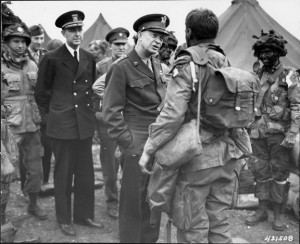
Gen. Eisenhower visits 101st Airborne just before D-Day on June 5th 1944 at their airfield in England
In December 1943, President Roosevelt announced that General Dwight D. Eisenhower would be designated as the Supreme Allied Commander to lead the combined Allied forces for the invasion of Europe on D-Day, June 6th 1944. Eisenhower graduated from the US Military Academy at West Point with the Class of 1915. He began his military career in the infantry and served stateside during World War I, much to his chagrin. He later was assigned to served in the new tank corps and after the war was over, developed a close friendship with a fellow tank corps officer, George S. Patton. Like many officers in the post World War I army, his career progression stagnated; however he made some close associations with mentors like General Fox Conner and later General Douglas MacArthur whom he accompanied to the Phillipines when MacArthur retired from the US Army to train the Philippine Army. Eisenhower also distinguished himself by graduating first in his class at the army Command and General Staff College at Ft. Leavenworth, Kansas.
When World War II began in Europe, Eisenhower was reassigned back to the US and after a series of assignments was brought to Washington DC to serve under the Army Chief of Staff, General George C. Marshall, as the head of the War Plans Divsion. He was quickly promoted to Brigadier General in this assignment, and although he was a relatively junior general officer, he demonstrated his ability not only for planning, but more importantly for dealing with people who had strong personalities and were often senior in rank. These were leadership qualities that were noticed by General Marshall and at his urging to President Roosevelt and Prime Minister Churchill, General Eisenhower was selected to command the first combined British and American operation for the invasion of North Africa. As the Commander for Operation Torch and the subsequent Operation Husky to invade Sicily, Eisenhower demonstrated his remarkable skill for fostering teamwork among the Allied commanders. This skill for handling the strong personalities of the different commanders and forging them into a cohesive team was the primary factor for his selection as the Supreme Commander for the invasion of France in 1944. No other general, either American or British, with the possible exception of Marshall himself, could effectively lead the coalition. Although Eisenhower’s patience was tested on many occasions, it was his ablitly to build and maintain an effective team that was more important to his success than technical war-fighting skills. He deserves much credit for the final victory in Europe for this leadership ability to forge an effective team which is immeasurably more difficult when your command is a combined Allied force. Although other generals often were getting headlines for the exploits of their units, it was Eisenhower at the helm that made the combined Allied effort effective.
You can read more about Eisenhower’s career both during and after the war at the following link: http://en.wikipedia.org/wiki/General_Eisenhower
Written in the format of a Staff Ride
VICTORY PRINCIPLES is written in the three part format of a Staff Ride, the same technique used to train army officers. A staff ride focuses the study of history on leadership “lessons learned” that can be applied in the future. Part one of this book is the fascinating story of D-Day itself. Part two describes seven timeless leadership lessons, the VICTORY PRINCIPLES. Part three is a guide to the battlefield sites on the northern coast of France and what you would find there today.
Staff Rides were originated in the 19th century by the German army to train their general staff officers. General staff officers studied and visited the European battlefields from the Napoleonic Wars to deduce lessons learned for the future. The Staff Ride methodology was later adopted by the US Army prior to World War I when officers attending advance military schooling studied Civil War battles and subsequently made on-site visits. Their visits helped to visualize and understand the lessons learned by walking the actual terrain of the battlefield. Today, Staff Rides are still a popular teaching technique used at the US Army Command and Staff College at Ft. Leavenworth, KS. and by other military agencies.
